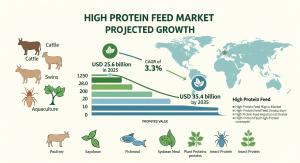High-Protein Feed Market to Surpass USD 35.4 Billion by 2035, Driven by Rising Poultry, Swine, and Aquafeed Demand
High-Protein Feed Market Poised for Growth, Paving Way for Manufacturers to Solve Industry’s Toughest Challenges
NEWARK, DE, UNITED STATES, August 5, 2025 /EINPresswire.com/ -- The global high-protein feed market is projected to grow from USD 25.6 billion in 2025 to USD 35.4 billion by 2035, a solid 3.3% CAGR. This expansion is driven by a critical need for high-quality, efficient protein sources to support rising global livestock production. However, this growth is not without its hurdles.
Manufacturers face persistent challenges, including price volatility of raw materials like soymeal, inconsistent regulatory approvals for novel proteins, and a lack of advanced technical infrastructure among smaller producers. This presents a clear opportunity for manufacturers to lead by offering compelling solutions that address these pain points, fostering trust, and securing a competitive edge in a rapidly evolving market.
Seizing the Future: A Strategic Blueprint for Manufacturers
To thrive in this market, manufacturers must shift their focus from simply supplying ingredients to providing integrated solutions. The data highlights a clear path forward.
1. Leverage the Dominance of Soybean Meal, but Prepare for a Diversified Future: Soybean meal currently holds a commanding 39% market share and remains the foundational high-protein source due to its balanced amino acid profile and cost-effectiveness. Manufacturers should continue to optimize their processing and distribution of soybean meal, particularly in pre-mixes for the dominant poultry and swine sectors.
However, the market is signaling a future of diversification. As countries like China aim to reduce their reliance on soymeal, there is an accelerating demand for alternative proteins like corn protein, DDGS, and insect meal. Manufacturers can build a competitive advantage by investing in R&D and scaling up production of these novel proteins, positioning themselves as forward-thinking partners ready to meet future market demands.
2. Innovate with Pellets and Formulations for Growth: The market is clear: pelletized feed is the preferred format, holding a 31% share due to its stability, ease of use in automated feeding systems, and enhanced microbial control. Manufacturers must invest in upgrading their extrusion and pelleting infrastructure to meet this demand, especially in climate-sensitive regions.
The data also points to a sweet spot in protein concentration, with the 30-50% protein range accounting for a significant 45% market share. This range offers the ideal balance for a variety of livestock applications. Manufacturers should standardize their product lines within this range, developing highly customizable, growth-promotion formulations that meet specific performance metrics for poultry, swine, and aquaculture.
3. Address Supply and Regulatory Gaps through Strategic Partnerships: Price volatility of raw materials and lengthy regulatory approval timelines for new proteins are major pain points for manufacturers. The solution lies in building robust and integrated supply chains. Manufacturers can secure their supply by backward integrating into oilseed processing or forming long-term B2B contracts with farms and cooperatives, a distribution model that already commands a 37% market share. To navigate the complex regulatory landscape, they should collaborate with industry alliances and leverage the expertise of larger players.
For example, Nutreco's investment in cell-feed technology, a highly regulated and technical field, demonstrates a commitment to solving future challenges at a large scale. By proactively addressing these issues, manufacturers can provide a stable and reliable supply chain that mitigates risk for their customers and positions them as a trusted, long-term partner.
Top Market Dynamics
Two central forces are driving the high-protein feed market: the imperative to diversify away from soymeal and the persistent challenges of price and regulation. The market is increasingly seeking alternative proteins to support feed efficiency and reduce dependency on traditional sources. However, this shift is complicated by the price instability of both conventional and novel ingredients, as well as the fragmented and slow regulatory approval process. Manufacturers who can deliver consistent quality at a predictable price, while also championing the approval of new, sustainable protein sources, will emerge as market leaders.
Regional Insights and Key Players
The growth of the high-protein feed market is global, but its nuances are regional. India leads with a 3.6% CAGR, driven by a strong demand for protein-enriched dairy and poultry feed and supported by state-backed procurement schemes. This presents a prime opportunity for manufacturers who can blend native protein sources with essential synthetic amino acids to meet minimum digestibility benchmarks. Australia and China are also showing strong growth, with Australia focusing on native proteins like lupin and faba bean for ruminants, and China accelerating its use of soy protein concentrates and fermented meals in aquaculture and swine diets.
The competitive landscape is dominated by vertically integrated giants with vast resources. Cargill Inc. and Archer Daniels Midland Company (ADM) are the global powerhouses, controlling the supply of core protein sources like soybean and canola meal. Nutreco differentiates itself through value-added, high-protein blends and a strategic eye on future innovations like cell-cultured protein. Alltech Inc. is carving out a niche with its focus on yeast-based proteins and fermentation technologies, while Ridley Corporation serves the Asia-Pacific market with regionally tailored formulations.
These players demonstrate that success requires a combination of scale, strategic diversification, and a commitment to addressing the evolving needs of the global animal nutrition sector. By following a similar solution-focused approach, manufacturers can build a resilient and profitable business for the future.
Request High-Protein Feed Market Draft Report - https://www.futuremarketinsights.com/reports/sample/rep-gb-22464
For more on their methodology and market coverage, visit https://www.futuremarketinsights.com/about-us.
Explore Related Insights
High-Protein Pudding Market: https://www.futuremarketinsights.com/reports/high-protein-pudding-market
High Protein Yogurt Market: https://www.futuremarketinsights.com/reports/high-protein-yogurt-market
High Protein Dog Food Market: https://www.futuremarketinsights.com/reports/high-protein-dog-food-market
Editor’s Note:
This release is based exclusively on verified and factual market content derived from industry analysis by Future Market Insights. No AI-generated statistics or speculative data have been introduced. This press release is based on a market analysis report on the global high-protein feed market. All data and figures are sourced directly from the provided content.
Rahul Singh
Future Market Insights Inc.
+1 347-918-3531
email us here
Legal Disclaimer:
EIN Presswire provides this news content "as is" without warranty of any kind. We do not accept any responsibility or liability for the accuracy, content, images, videos, licenses, completeness, legality, or reliability of the information contained in this article. If you have any complaints or copyright issues related to this article, kindly contact the author above.
Accounts Receivable Outsourcing Services Support Financial Clarity Across U.S. Healthcare
American Receivable Celebrates 46 Years of Success and Steady Leadership
Global Ready-Mix Concrete Market Is Expected to Reach $704.2 Billion by 2030: Says AMR
Więcej ważnych informacji
 Jedynka Newserii
Jedynka Newserii

 Jedynka Newserii
Jedynka Newserii

Polityka

D. Joński: Nie wiemy, co zrobi Rosja za dwa–trzy lata. Według duńskiego wywiadu może zaatakować kraje nadbałtyckie i musimy być na to gotowi
Zdecydowana większość krajów unijnych wskazuje na potrzebę wzmocnienia zdolności obronnych Europy w obliczu coraz bardziej złożonego geopolitycznego tła. Wywiady zachodnich państw wskazują, że Rosja może rozpocząć konfrontację z NATO jeszcze przed 2030 rokiem. Biała księga w sprawie obronności europejskiej „Gotowość 2030” zakłada m.in. ochronę granic lądowych, powietrznych i morskich UE, a sztandarowym projektem ma być Tarcza Wschód. – W budzeniu Europy duże zasługi ma polska prezydencja – ocenia europoseł Dariusz Joński.
Transport
Duże magazyny energii przyspieszą rozwój transportu niskoemisyjnego w Europie. Przyszłością może być wodór służący jako paliwo i nośnik energii

Zmiany w europejskim transporcie przyspieszają. Trendem jest elektromobilność, zwłaszcza w ramach logistyki „ostatniej mili”. Jednocześnie jednak udział samochodów w pełni elektrycznych w polskich firmach spadł z 18 do 12 proc., co wpisuje się w szerszy europejski trend spowolnienia elektromobilności. Główne bariery to ograniczona liczba publicznych stacji ładowania, wysoka cena pojazdów i brak dostępu do odpowiedniej infrastruktury. – Potrzebne są odpowiednio duże magazyny taniej energii. Przyszłością przede wszystkim jest wodór – ocenia Andrzej Gemra z Renault Group.
Infrastruktura
W Polsce w obiektach zabytkowych wciąż brakuje nowoczesnych rozwiązań przeciwpożarowych. Potrzebna jest większa elastyczność w stosowaniu przepisów

Pogodzenie interesów konserwatorów, projektantów, inwestorów, rzeczoznawców i służby ochrony pożarowej stanowi jedno z największych wyzwań w zakresie ochrony przeciwpożarowej obiektów konserwatorskich. Pożary zabytków takich jak m.in. katedra Notre-Dame w Paryżu przyczyniają się do wprowadzania nowatorskich rozwiązań technicznych w zakresie ochrony przeciwpożarowej. W Polsce obowiązuje już konieczność instalacji systemów detekcji. Inwestorzy często jednak rezygnują z realizacji projektów dotyczących obiektów zabytkowych z uwagi na zmieniające się i coraz bardziej restrykcyjne przepisy czy też względy ekonomiczne.
Partner serwisu
Szkolenia

Akademia Newserii
Akademia Newserii to projekt, w ramach którego najlepsi polscy dziennikarze biznesowi, giełdowi oraz lifestylowi, a także szkoleniowcy z wieloletnim doświadczeniem dzielą się swoją wiedzą nt. pracy z mediami.




![Nestlé w Polsce podsumowuje wpływ na krajową gospodarkę. Firma wygenerowała 0,6 proc. polskiego PKB [DEPESZA]](https://www.newseria.pl/files/1097841585/fabryka-nesquik_1,w_85,r_png,_small.png)




.gif)

 |
| |
| |
|